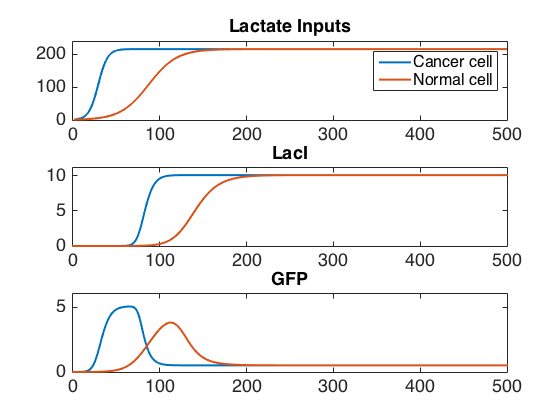Team:ETH Zurich/Modeling
- Project
- Modeling
- Lab
- Human
Practices - Parts
- About Us
Modeling
Overview
Our system consists of a signalling chain, with a lactate sensor triggering the amplification of AHL production which is sensed my neighboring cells. When AHL becomes sufficiently concentrated, it triggers the production of a fluorescent signal. Our model was divided into the modules pictured below.
These were modeled and tested independently before being merged into a single model of the whole system. Each module was first evaluated and characterized at the single cell level in MATLAB in order to evaluate their initial states, steady states, and to study their dynamics. Then, each module was implemented in COMSOL Multiphysics to characterize their spatial and temporal behavior, and to implement additional biological properties of our system.
The final result is a model providing a reasonable approximation of the behavior of our system under our test conditions. In addition, our characterization of the lactate module is a significant contribution to the understanding of this system.
Goals
Lactate module
Figure 2. Simplified topology of the lactate sensor
The lactate sensor is a fold-change sensor with the topology of an incoherent feed-forward loop. As shown in Figure 2, LuxR production is repressed by both LacI and LldR (the feed-forward), but LacI is produced when LldR binds lactate and is no longer a repressor. When the activation of LacI is delayed relative to the action of LldR on the promoter of LuxR, the action of lactate produces a pulse of LuxR whose amplitude depends on the rate of lactate production until LacI becomes active.
Due to the lack of a quantitative characterization of LldR's function, a reasonable subspace of parameters for the system had to be estimated before lab results could be used to determine them.
When the sensor was implemented in a reaction-diffusion model with cells that take up lactate at rates dependent on their proximity to a lactate producer, a higher rate of LuxR production was observed in the proximal cells with dynamics resembling the production phase predicted in the single cell model.
AHL module
The quorum sensing module is based on the LuxR-AHL system. In our system, the complex of LuxR with N-acyl homoserine lactone (AHL) promotes the transcription of LuxI and our signalling GFP. LuxI produces AHL that can bind to more LuxR, creating a positive feedback loop. This system relies on the leaky expression of LuxI to produce an initial concentration of AHL, but this leakiness also means that when run in a small volume, our system will self-activate.
Combined model

GFP concentration over time in four cases: A) Cancer cell, bound E. coli B)Cancer cell, unbound E. coli C) Normal cell, bound E. coli D) Normal cell, unbound E. coli
Conclusions
We characterized our system by simulating its modules separately and together through a series of increasingly-complex models. We show that under certain parameters, our lactate module is able to produce LuxR such that the lactate production input signal is amplified. Simulation of the AHL module with a simplified compartment model and with a more accurate reaction-diffusion model show that degradation of AHL by the E. coli does not significantly delay the self-activation of our LuxI and AHL production feedback loop. Instead, riboregulation of the LuxR promoter to prevent leaky expression of LuxI is sufficient to prevent this self-activation within the timescale of our experiment. This demonstrates the viability of our system as a specific CTC detection system utilizing these two general cancer markers.






















